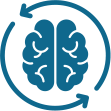Good Drug Policy is Grounded in These Principles
Essential Elements of Good Drug Policy
A Word From Our CEO

The use of addictive substances, such as alcohol, nicotine, and other drugs, should be highly discouraged throughout one’s lifetime, with special attention focused on children.

Drug policy must be informed by science, data, and evidence-based practices. Those with lived experience, victims of drug use and addiction, and others should also inform policy. Good policy must be free from political influences that contradict science and from economic interests that are misaligned with public health. It should be presented in a format accessible to decision-makers and the public.

A comprehensive array of strength-based strategies and supports are needed to ensure the health and wellness of individuals, families, children, youth, and communities can thrive.

The full range of prevention strategies must be implemented to meet the needs of universal, selective, and indicated populations to stop the initiation of psychoactive substance use, delay the age at which use begins, provide brief interventions, prevent escalation to a substance use disorder, and prevent relapse among those seeking recovery.

Reducing substance use to the lowest possible rates, with the visionary goal of being “drug-free” is important in setting the overarching goal for drug policy advocacy and helping all people achieve their highest life potential and standard of health.

A substance use disorder is a preventable, chronic, yet treatable brain disorder with behavioral expression – a unique biobehavioral disorder from which people can and do recover.

All individuals with a substance use disorder deserve access to evidence-based treatment, including medication-assisted treatment (MAT), which should be as accessible and affordable as any other kind of health treatment.

There are many paths to recovery, and relapse can be part of this path. If symptoms resurface, treatment should be made available or adjusted as clinically indicated.

Recovery is a voluntarily maintained lifestyle composed and characterized by sobriety, personal health, and citizenship. Wellness from a substance use disorder takes place on a continuum, where a life without the use of illicit substances and activity is the ultimate goal for individuals and families.

Drug law enforcement plays a crucial role in limiting drug supply and an equally crucial role in promoting justice and preventing and limiting collateral damage created by drug markets and supply, including limiting violence, corruption, and other adverse effects on quality of life.

Policies designed to prevent or limit the movement of drugs and their precursors across international borders from their initial cultivation and production to consumer retail sale necessarily rely upon a comprehensive plan with international cooperation for its successful implementation.

Policymakers should consider implications for equity and cost-effectiveness when deciding whether to implement and fund an intervention.

While arrest is one means to limit the supply of drugs and their collateral damage, it is also critical to achieve this goal in ways that provide alternatives to incarceration.

A significant number of individuals involved in the justice system suffer from a substance use disorder, so this is a unique and essential venue to connect people with the treatment and services they need.

Timely and comprehensive data must be prioritized as quality data is necessary to quickly respond to emerging trends and threats.

Justice systems encounter a wide variety of individuals involved with drugs, and need to understand when to utilize enforcement, when to facilitate therapeutic interventions, and when to employ punishments.

Multi-system collaborations between justice, health, and community such as deflection and diversion are needed to help individuals with substance use disorders who become entangled with the justice system for non-violent charges, applying components of prevention, treatment, recovery, and accountability, where appropriate.